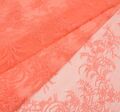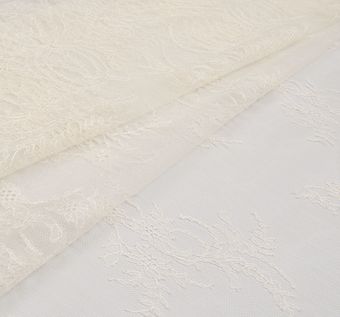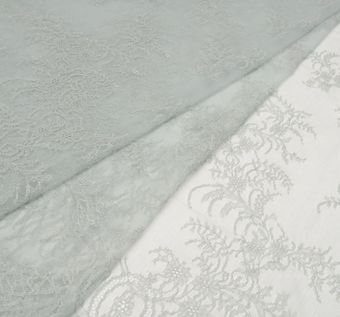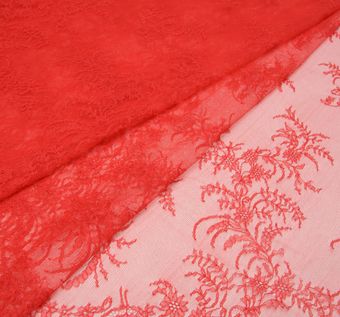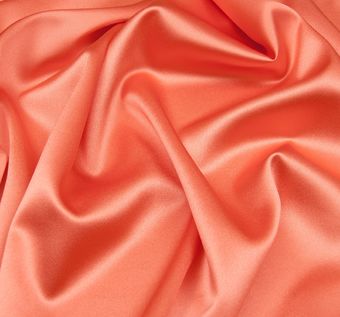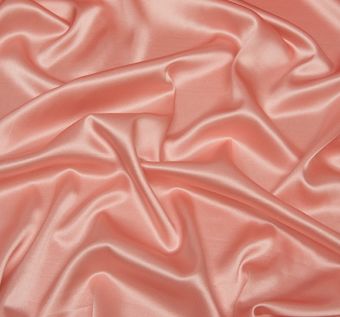Chantilly Lace
1 m = 1.1 yd
Characteristics
| Composition: | 65% Polyamide 35% Viscose |
| Width: | 110 cm |
| Manufacturer: | Sophie Hallette |
| Country: | France |
| Categories: | Dresses, Skirts |
This scalloped Chantilly lace fabric features an exquisite floral pattern in coral. Lightweight and sheer, it is produced in France by the House of Sophie Hallette. The classic design has been created based on the archival collections of lace popular among the renowned fashion houses in the 50s. Chantilly lace is often used for decorative purposes, overlays and apparel accents. It can be layered over solid fabrics for a romantic twist. This French lace is available in a range of fashion colors, developed exclusively for Tissura.
What is Lace?
Lace has a disputable origin since it evolved from other techniques. This beautiful openwork can be either English or French legacy. Even if it was Italian, the world would love it just as much. Handcrafted and machine-made, it was widespread in Europe by the 16th century. Lace is named after the Latin word laqueus, which means “noose”. Equally valued by the early Catholic Church clergy and city fashionistas, this fabric has a number of production techniques:
- knotted lace, such as macramé and tatting,
- cutwork, or whitework,
- machine-made lace,
- chemical lace,
- crocheted lace,
- tape lace,
- knitted lace,
- needle lace,
- bobbin lace.
These days not all these varieties are widespread. Different kinds of lace keep falling in and out of fashion, but some are here to stay. Modern lace producers offer a rich variety of
- Chantilly lace,
- corded lace,
- guipure lace,
- embroidered lace,
- Lyon lace.
Top 5 lace colors are white, black, pink, blue and red. Floral patterns are a timeless classic that never fails.
Chantilly Lace
Chantilly lace got its name from the city Chantilly in the Northern France. The interesting point is that this bobbin lace was mostly made by hand in the French city Bayeux. Famous since the 17th century, this delicate fabric was initially used as mourning wear. Black Chantilly lace with an ornate floral pattern is outlined with cordonnet, a fine strand. It looks equally chic made into
- a shawl,
- a scarf,
- a special occasion dress,
- lingerie.
When it comes to high-quality dress material, silk Chantilly lace is one of the most popular choices both for evening dresses and day dresses – all because of its look, feel and hand. These lightweight laces are used for bridal dresses and special occasion garments and often paired with contrasting fabrics like silk satin, velvet and even leather. Feminine and airy white Chantilly lace is perfect for a bridal dress or a wedding gown. A backless evening dress sewn of embroidered Chantilly lace is a real power piece of one’s wardrobe.
How to Sew with Lace?
Lace, as well as many other fabrics, has its underlying potential problems when it comes to sewing. Due to its gossamer-like structure, this fabric can be a real challenge for those who have just started their sewing lessons. There are several tips that can help you turn Chantilly lace into a beautiful piece of clothing.
- Mind the side. Sometimes lace looks the same on both sides, but in most cases, they differ. One should mind the face side, especially while working with multiple lengths of lace fabric. It’s a good idea to use stickers or removable tailor’s chalk to indicate it.
- Symmetry is key. While designing the dress, consider the ornament direction and place the fabric accordingly. Estimate the length of the dress so as to place scallops symmetrically
- Always prepare your fabric before cutting. Steam ironing might work for cotton lace, but it all depends on the type of fabrics – mostly only dry-cleaning is allowed. The best strategy is to follow the manufacturer’s guidelines.
- If you need to secure your fabric, opt for fine and sharp silk pins. You may also use weights to keep it in place.
- Sharp scissors are a key to success. We recommend using special scissors or a rotary cutter for cutting lace. Use tone-on-tone thread to avoid the contrast with delicate lace fabric. Viscose thread and thin needle are essential for handworks and beadworks.
- Overlap two pieces of lace to hide your seam. Carefully match the basting marks between the two pieces. It depends on the motif, but sew the new seam as close to your basted line as you can. Trim away excess at the overlap edges. You can pin and baste around the lapped seam and test until you're satisfied with how it looks.
- Pressing is quite tricky, too. Before pressing, cover lace fabric with some kind of protection, like a thick cotton towel. Or, you could also use a special iron shoe.
Chantilly Lace
Chantilly lace is a fine and delicate type of French lace, known for its light weight, exquisite floral patterns and pure femininity. Despite its airiness, this lace is very durable.
Chantilly lace is made on a hexagonal mesh ground, with an ornate floral pattern sometimes outlined in a heavier silky thread. It is usually designed with double scalloped edges. Traditional Chantilly lace is black, but today it can be dyed in any color. White and ivory are among the most popular ones, which explains why the fabric is often used as a bridal lace.
This lace has always been perceived as the sign of luxury and high social status, since the production involved lots of manual work. Iconic French brands still use authentic 19th century looms to deliver the original spirit we love this fabric for. Exquisite and stylish, Chantilly lace is often seen on the world’s most famous catwalks during fashion weeks, transformed into luxurious dresses and gowns.
Sophie Hallette Lace
Sophie Hallette lace has always been the synonym of luxury and refined taste. Woven on the 19th century British looms in the French city of Caudry, this lace attracts in many ways: impeccably woven, it features a charming vibe of more than century-old French weaving traditions and comes in a vast range of luxurious designs. Chantilly, guipure, corded and beaded laces by this French brand please the eye with floral, ornamental and geometric patterns. Sophie Hallette laces are regularly chosen by the world-renowned fashion designers to be transformed into mind-blowing masterpieces of haute couture. Not surprisingly, these fabrics have become iconic for millions of fashionistas all around the globe.
The brand itself deserves attention as well. Founded in 1887, over the years, Sophie Hallette has created a strong reputation for making lace for haute couture and ready-to-wear segments. This lace can be used for various occasions, be it weddings, cocktail parties or even red carpet ceremonies.
French Lace
French lace fabric is a type of lace with delicate woven patterns made in France. This group of laces comprises Chantilly, Lyon, corded, guipure, macrame and other lace types.
In the world of high fashion fabrics, French lace is a sign of luxury and femininity. Lace dresses are traditionally considered to be an inseparable part of bridal dress fashion. In 1956, princess Grace Kelly went down the aisle with the prince of Monaco Rainier III in gorgeous Alençon lace. Another royal wedding with French lace happened in 2011, when the duchess of Cambridge Kate Middleton wore a graceful dress decorated with Caudry lace. Her ivory gown was embroidered with roses and daffodils.
No fashion week goes without French laces in designer collections.
Delightful French lace patterns imbue the dresses with the French charm and elegance.
French lace is a luxurious fabric, and its production still requires lots of craftsmanship.
Payment and Delivery Terms
We offer worldwide shipping on all items in Tissura online shop. Delivery to USA, UK, UAE, Australia and rest of the world.
We accept bank transfers and payments by credit and debit cards. Learn more about our payment and delivery terms.
Fabric by the Yard: Measurement Conversion
All fabrics on our website are priced by the running meter. The term "running meter" or "linear meter" is used in the fabric industry.
To convert meters to yards, use the conversion factor 0.9144. In other words,
1 Yard = 0.9144 Meters
1 Metre = 1.0936 Yards

